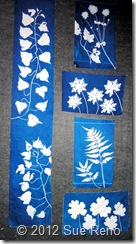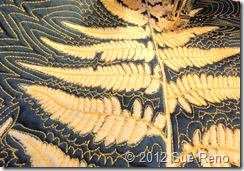
Having assembled my components - the cyanotype prints and the Seminole patchwork strips - it was time to work on the overall design and assembly of the quilt top. I started by arranging the cyanotype prints on my one of my movable design walls (a large sheet of construction foam, covered with felt and mounted on a wooden framework). I don’t dither a lot at this stage of the process. I have a general idea in my head all along of how I’d like thing to go, and putting it up on the wall mainly serves to validate my internal vision. I do take some time with the process, though, studying it over the course of several days, walking into the room and glancing at it like I was discovering it for the first time. In this instance, I ended up switching the position of the fern and the Japanese anemone prints, putting the fern on the top right. I liked the way it curved, and directed the eye, in that position.
While I was thinking about the positioning, I took each print down and did the first round of stitching on it. I often work this way, layering a print with batting and a thin backing, and doing intensive quilting on it while it’s small enough to be relatively easily maneuverable under the needle. I do all of my work, piecing and quilting, on a domestic sewing machine (as opposed to a long arm quilting machine, where the entire quilt sandwich is mounted on rollers and quilted by a movable machine head), and over the years I have developed methods for adding a lot of detailed stitching work without threatening my sanity.

The next, and exciting step, was to mock up the entire quilt top, pinning on the patchwork strips in their probable locales. At this point the vision starts to become manifest, and it’s very gratifying! Again, I will tweak things a bit, making sure that the colors and values are balanced across the work, and that the eye travels as you view it but doesn’t wander too far. But for the most part this is a close approximation of the final composition. This is the mystical part, where if I am wise I will turn off any internal dialogue and let my unconscious take the wheel. I don’t do sketches, or diagrams, or plan things out quantitatively ahead of time. It all takes shape in my head, I think about it intently as I work to assemble the components, and I’ve learned to trust myself. Amazingly, I usually end up with exactly the right amounts of patchwork, with just a bit to spare.
This might be a good place to admit that I hate measuring things. I don’t do it when I cook, for the most part, and I do as little of it a possible when working in the studio. I find that putting a numerical value on an object unnecessarily places a barrier between myself and the experience of the object. I understand and in fact applaud the use of valuation in the scientific method - I’m a big fan of science - but my artwork is not a scientific process. It’s the telling of a story, and the conveyance and expression of an occurrence in time and space. Breaking it down into measurements is not helpful for me. So with experience I’ve developed a set of strategies that allow me to mostly delay measurement until the work is completed and I need to record the dimensions. This project was a bit trickier because I had to build it to a specific size, rather than my usual method of letting it grow organically, but I was able to make the necessary mental leaps and it worked out ok.

Logistical note: this quilt is actually finished, as the photo deadline was some time ago. I’m still working on finishing up the documentation, and looking forward to the big reveal of all the quilts in this exhibit at the International Quilt Festival in Houston this fall. Thanks for reading and following along!